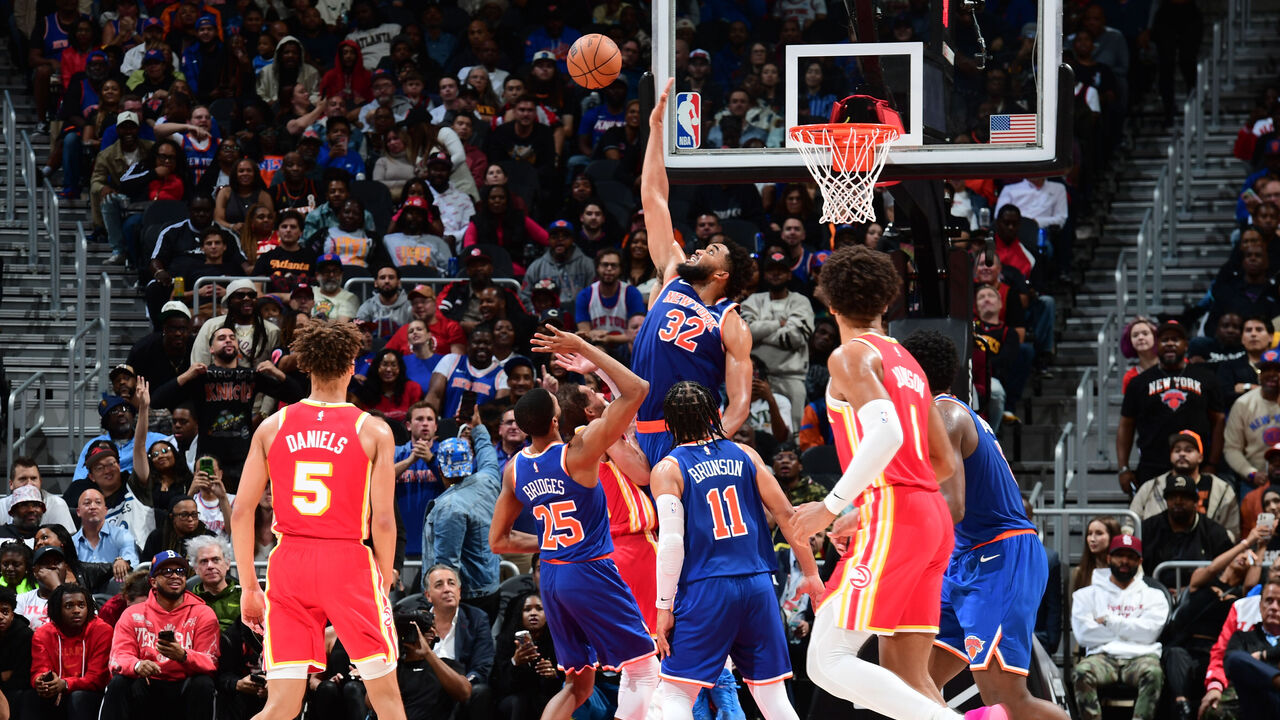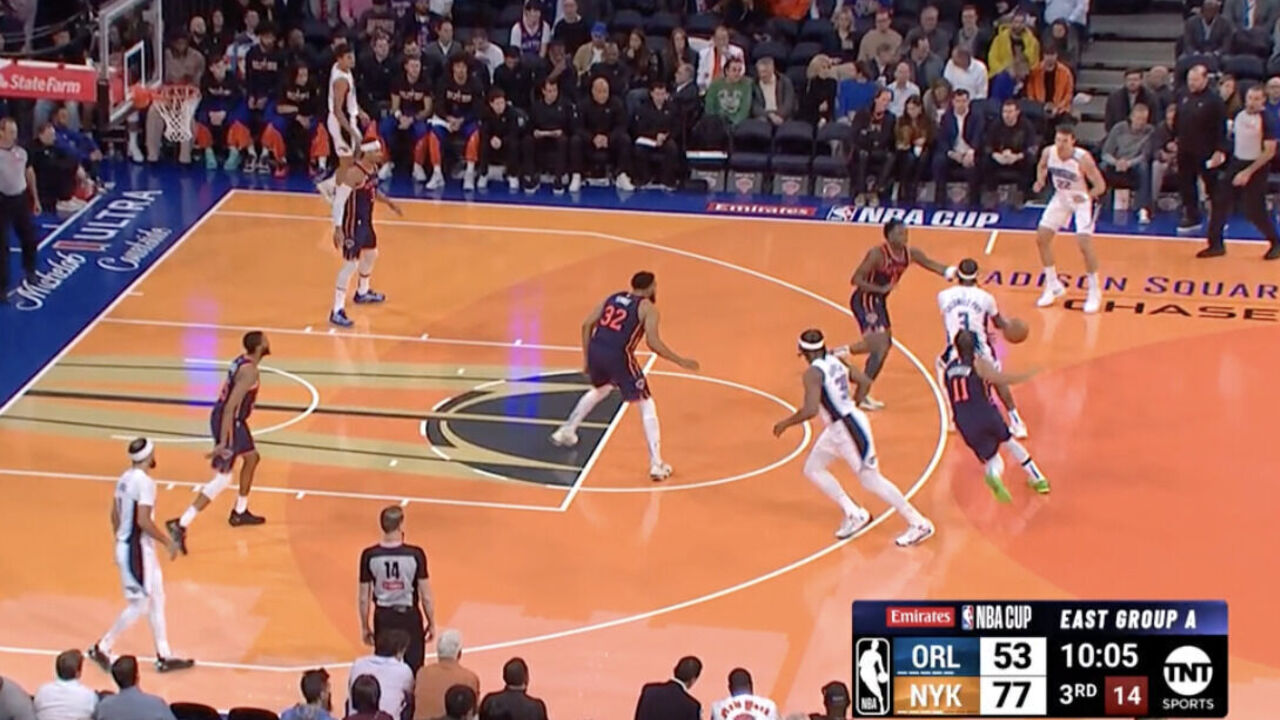Knicks' quietly improved defense makes them look like contenders
You wouldn't know it from the way people talk about the New York Knicks' defense - or, frankly, from how it looks on some nights - but they rank sixth in the NBA in points allowed per 100 possessions since the start of December.
That's pretty impressive work from a team that starts limited defenders at both the one and the five, and it's a far cry from how the Knicks performed on that end of the court for the first six weeks of the season, after which they ranked 23rd.
Their true talent level on defense probably lies between those extremes, which is illustrated by the fact that their run of success has merely pulled them up to league average. Still, it's notable when a team that's this good offensively proves capable of defending at a borderline top-five level for an extended stretch (even if that coincided with a pretty soft schedule). For the record, New York's 119.4 offensive rating is 7.3 points per 100 possessions better than league average, making it (for now) one of the 20 best relative offenses in NBA history, per Basketball Reference.
It's a little reminiscent of what happened a couple years ago with the Denver Nuggets, a similarly fearsome offensive team - also built around a dominant guard-big pairing - that managed a similar defensive turnaround after a disastrous start. They too had to scheme around a center who was limited as a rim-protector and defender in space. They figured it out - albeit using different tactics than New York is using - and their improvements turned out to be sustainable, as they romped to the title with the league's fourth-ranked playoff defense. (Last year's West-winning Mavericks are another example, though their turnaround was powered by a couple of key midseason transactions.)
That's not to say these Knicks will win the 2025 championship. For as extraordinary as he's been in his first year in New York, Karl-Anthony Towns is not Nikola Jokic. And maybe more to the point, the Knicks are playing in a conference that's a lot tougher (at least at the top) than the one Denver ripped through. Those Nuggets never had to contend with a team remotely comparable to this year's Cavaliers or Celtics. Or this year's Thunder, for that matter, which might be a consideration if New York can somehow overcome those daunting East foes.
But just because the Knicks aren't favorites to win the title or even their own conference doesn't mean they don't deserve to be taken seriously as contenders. That might feel like an obvious statement about a team that's on pace to win 52 games and ranks fifth in the league with a plus-6.5 net rating halfway through the season, but it wouldn't be the case without their recent run of high-level defensive play. So let's examine where and how they've improved, and what those improvements mean in the big picture.
When a team makes a sudden defensive shift in one direction or another, it's helpful to start by looking at their opponent shooting to gauge how much variance may be involved. In this case, the answer is some, but not a lot. Knicks opponents have shot 37% from 3-point range since the start of December, which is the 10th-highest mark allowed over that stretch. On long mid-rangers, however, opponents have shot just 29.5%, which is the lowest in the league by a mile. If their opponents had shot exactly league average from both those zones, the Knicks' defense would rank 10th during this period rather than sixth - still a considerable improvement from where they started the season.

They've made their biggest gains on the interior, and that starts with the man in the middle. Towns has been one of the five best offensive players in basketball this year, but after spending two seasons starting at power forward next to Rudy Gobert in Minnesota, his move back to playing the five full time posed some defensive problems for his new team. Namely, opponents shot 76.7% against him at the rim through November. For reference, the highest percentage allowed by a qualified big man in the 12 years that NBA.com has tracked those numbers is 70.3%, conceded by Nemanja Bjelica in 2019-20. So, yeah, really bad.
Since the start of December, though, that's come down to 61.1% - not great by any means, but passable enough that it won't sink a defense by itself. It's almost identical to Rockets center Alperen Sengun's season-long mark (61.6%), for example, and Sengun mans the five for the league's third-ranked defense. And New York's 107.1 defensive rating with Towns on court since Dec. 1 (down from 115.9 beforehand) is right in line with Houston's overall mark.
The fact that Towns is no longer tissue paper on the back line is particularly important given the way New York has shifted its priority toward taking away threes in recent weeks, accepting an uptick in opponent rim shots as a consequence. After allowing the league's fourth-highest rate of 3-point attempts through November, they've allowed the third-lowest 3-point rate since, per Cleaning the Glass. In short, they're funneling more guys toward Towns at the rim, and he's doing a much better job of turning them away.
The Knicks have experimented with up-to-touch and hard-hedging pick-and-roll coverages, but they've mostly deployed Towns in a deep drop. That's a bit of a departure from his last few years with the Timberwolves, who regularly brought him up higher on the floor to try to mitigate his limitations around the rim. Towns hasn't done a great job of containing the ball when he's played those more aggressive coverages this season, but maybe we'll see more of it when Mitchell Robinson gets back and the two bigs play together. We've seen it work on the rare occasions when Towns and Precious Achiuwa share the court.
In the meantime, the Knicks have increased their emphasis on stunting aggressively from one pass away against middle pick-and-rolls to protect the Towns drop:

Their conservatism means they don't force a lot of turnovers, but they don't allow many second chances either - and that's largely thanks to Towns, who's hauling in a league-leading 10.9 defensive boards per game. New York has a 73.8% defensive rebound rate with him on the floor (which would rank first in the league) and 70% with him on the bench (which would rank 23rd).
The Knicks' early-season defensive wobbles weren't Towns' fault alone. They also had a lot to do with New York's other big offseason acquisition, a wing for whom they shelled out five first-round draft picks in part because of his defensive reputation. Mikal Bridges' reworked, funky-looking jumper attracted a lot of scrutiny at the start of the campaign, overshadowing his more worrisome decline on defense. He struggled badly with screen navigation and overall dribble contaimment, which were supposed to be his calling cards.
Those struggles exacerbated Towns' limitations. Not only was the big man often left in tough one-on-two situations as a result, but he was also often forced into undesirable switches due to Bridges' inability or unwillingness to fight through screens.
That's still happening more often than the Knicks would like like, but while Bridges still hasn't come close to the standard he set during his Suns days (and may never do so again), his on-ball defense has improved dramatically in recent weeks, especially his efforts in rear-view pursuit. Compare his passivity and the way he capitulated on screens against Tyrese Haliburton back in November ...
... to the way he pressed up, got skinny, and worked to stay in contact with Damian Lillard and Cade Cunningham this past week:
Again, there are still some ugly possessions, and this recent version of Bridges still isn't the defender the Knicks probably thought they were getting. But simply not being a liability has gone a long way: His on-court defensive rating was 117.6 through November, and it's down to 108.8 since then.
Early in the season, stalwart stopper OG Anunoby was stretched thin trying to handle his own assignments while also covering for Towns, Jalen Brunson, and Bridges.
OG Anunoby is such a damn good defender pic.twitter.com/3jK4X85oNW
— Jackson Frank (@jackfrank_jjf) November 13, 2024
Anunoby is still carrying an immense defensive workload, but he doesn't have to put out quite as many fires as he did back in October and November. He and the perpetually rock-solid Josh Hart are responsible for most of the team's event creation, averaging 4.3 stocks (steals plus blocks) and 5.9 deflections per game between them. They can both overhelp at times in pursuit of defensive playmaking opportunities, but the benefits of their activity level outweigh the downsides.
Brunson is inherently limited at that end of the floor, but at least he has one defensive superpower: drawing offensive fouls. He's drawn 32 of them this season, which is 23 more than any other Knick and ranks second in the league behind only Toumani Camara.
The Knicks have also gotten solid defensive contributions from their bench. That may be surprising considering that two of the three reserves who actually play real rotation minutes are 6-foot-2 and 6-foot-3, but Miles McBride and Cameron Payne have been genuine positives on that end - McBride with his feistiness at the point of attack, Payne with heady rotations and active hands digging down on drives. Achiuwa's return at the start of December relegated Jericho Sims to mop-up duty, and while Sims has excelled as a rim-protector (45.3% allowed at the basket), Achiuwa is a much more versatile defender.
Whether the Knicks can sustain this defensive level as their schedule gets tougher is an open question. Ugly recent losses to the Bulls, Pistons, Thunder, and shorthanded Magic revealed fissures that hearken back to their early-season woes. The starters' trademark Tom Thibodeau minutes load may be catching up to them. They still don't have a great solution for Brunson getting hunted in crunch time (which was how the Pistons pulled away down the stretch of Monday night's game). Rim-protection will remain a concern until Robinson returns.
But these Knicks weren't built to be elite defensively; they were built to be good enough on that end to let their overpowering offense carry the day, and over the last six weeks, that's exactly what we've seen. Doubts are warranted, but that's been a formula for major success in the recent past.
Joe Wolfond covers the NBA for theScore.